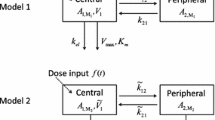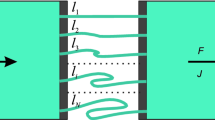Abstract
If the concentrationc 1(t)=∑ n i=1 A i exp (−α i t) for one compartment, one presumes a linear catenaryn-compartment system without sinks and loss only from the same compartment, then the volumesV i , rate constantsk ij , and concentrationsc i (t) in each compartment can be determined in terms of theA i 's,A i ′s, α i ′s, the dose injectedD o and the partition coefficientsr ij =k ij /k ji . If the concentration would become uniform at equilibrium, then the total volume of distribution may be determined without knowledge ofr ij or restriction to catenary configuration.
Similar content being viewed by others
Literature
Dominguez, R. 1950. “Kinetics of Elimination, Absorption and Volume of Distribution in the Organism.” InMed. Physics,2, 476–489 Ed. by O. Glasser. Chicago: Year Book Publishers, Inc.
Hart, H. E., U. Malid and D. Sugerman. 1972. “Determination of Reaction Rate Constants in the Mammillary System.”Bull. Math. Biophysics,34, 87–92.
Hearon, J. Z. 1953. “The Kinetics of Linear Systems with Special Reference to Periodic Reactions.” ——Ibid.,15, 121–141.
— 1963. “Theorems on Linear Systems.”Annals of the New York Academy of Sciences,108, Art. 1, 36–68.
— and W. London 1972. “Path Lengths and Initial Derivatives in Arbitrary and Hessenberg Compartmental Systems.”Math. Biosciences,14, 121–134.
— 1972a. “Compartmental Matrices with Single Root and Nonnegative Nilpotent Matrices.” ——Ibid.,14, 135–142.
— 1972b. “Residence Times in Compartmental Systems and the Moments of a Certain Distribution.” ——Ibid.,15, 69–78.
Hearon, J. Z. 1972c. Private Communication.
Mier, P. and K. L. Zierler. 1954. “On the Theory of the Indicator-Dilution Method for Measurement of Blood Flow and Volume.”J. Appl. Physiol.,6, Number 12, 731–744.
Rubinow, S. I. and Alice Winzer. 1971. “Compartment Analysis: An Inverse Problem.”Math. Biosciences,11, 203–247.
Sheppard, C. W. 1962.Basic Principles of the Tracer Method. New York: John Wiley and Sons,
Skinner, S. M., R. E. Clark, N. Baker and R. A. Shipley. 1959. “Complete Solution of the Three-Compartment Model in Steady State After Single Injection of Radioactive Tracer.”Amer. J. Physiol. 196 (2), 238–244.
Stephenson, J. L. 1958. “Theory of Measurement of Blood Flow By Dye Dilution Technique.”IRE Trans. Med. Electronics, PGME-12 82–88.
Taussky, Olga. 1949. “A Recurring Theorem on Determinants.”Amer. Math. Monthly,56, 672–676.
Author information
Authors and Affiliations
Rights and permissions
About this article
Cite this article
Bright, P.B. The volumes of some compartment systems with sampling and loss from one compartment. Bltn Mathcal Biology 35, 69–79 (1973). https://doi.org/10.1007/BF02558795
Issue Date:
DOI: https://doi.org/10.1007/BF02558795




